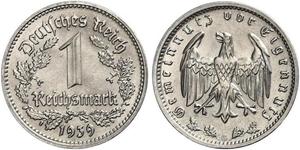3 Mark Grand Duchy of Saxe-Weimar-Eisenach (1809 - 1918) Silver W ...
Some description in:
Русский
36
coins in the group
View all coins in the group
View all coins in the group
(1537 X 746pixels, file size: ~214K)
Posted by: anonymous 2018-05-18
CoinWorldTV 1915, Saxe-Weimar-Eisenach. Silver 3 Mark "Grand Duchy Centenary Coin. XF+ Mint Year: 1915 Reference: KM-1266. Denomination: 5 Mark Condition: Toned and cleaned (hairlines), minor contact-marks, otherwise XF+ Material: Silver (.900) Weight: 16,66gm Diameter: 33mm Obverse: Co ...
(1500 X 750pixels, file size: ~232K)
Posted by: anonymous 2018-03-30
Sachsen-Weimar-Eisenach. Wilhelm Ernst 1901-1918. 3 Mark 1915 A. Jahrhundertfeier. Jaeger 163.Vorzüglich
(1500 X 753pixels, file size: ~212K)
Posted by: anonymous 2018-03-13
Sachsen-Weimar-Eisenach. Wilhelm Ernst 1901-1918. 3 Mark 1915 A. Jahrhundertfeier. Jaeger 163. Winziger Randfehler, winzige Kratzer, vorzüglich - Stempelglanz
(900 X 452pixels, file size: ~126K)
Posted by: anonymous 2017-12-14
Sachsen-Weimar-Eisenach, Wilhelm Ernst3 Mark 1915. Jahrhundertfeier. Jaeger 163. Vorzüglich - Stempelglanz
(900 X 451pixels, file size: ~132K)
Posted by: anonymous 2017-03-07
Sachsen-Weimar-Eisenach, Wilhelm Ernst 3 Mark 1915 A. Jahrhundertfeier. Jaeger 163. Feine Patina. Fast Stempelglanz
(900 X 453pixels, file size: ~159K)
Posted by: anonymous 2017-01-04
Sachsen-Weimar-Eisenach, Wilhelm Ernst 3 Mark 1915. Jahrhundertfeier. Jaeger 163. Vorzüglich - Stempelglanz
You may be interested in following coins
2024-04-26
- Historical Coin Prices
2024-04-26
- New coin is added to 2 Florin / 2 Gulden Austria-Hungary (1867-1918) Silver Franz ...
2 Florin / 2 Gulden Austria-Hungary (1867-1918) Silver Franz ...
group has 20 coins / 18 prices
⇑
1888, Austria, Francis Joseph I. Silver 2 Florin (Doppelgulden) Coin. NGC MS-63!
Mint Year: 1888
Mint Place: Vienna
Reference: KM-2233.
Denomination: 2 Florin (Doppelgulden)
Cond ...
You may be interested in ...

-500-250-w9QKbzbisI8AAAFPQlqA8Is4.jpg)
-300-150-CiAKqUpYoQwAAAFjCidEJHHX.jpg)
-300-150-AOMKqUpYTlUAAAFi2fKs73js.jpg)
-300-150-zlYKqUpYiS4AAAFiPLOs7yGF.jpg)
-300-150-F0gKqUpYLgcAAAFgoWg8PlLp.jpg)
-300-150-xf8KX9IS8tYAAAFax9hMgKmm.jpg)
-300-150-ifEKX9ISp8kAAAFZaNe9K2rr.jpg)







-300-150-KgQKX9ISLlMAAAFYVIy668M0.jpg)






